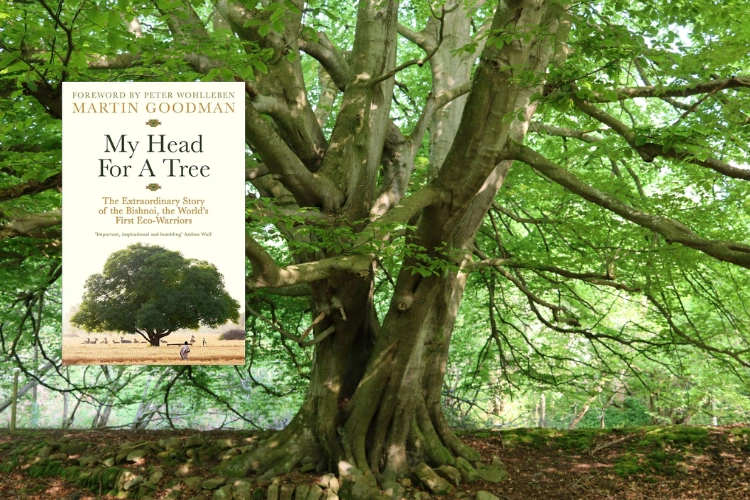
Goodman’s latest book dives into the extraordinary world of the Bishnoi, the planet’s first eco-warriors – and what we can learn from the community
By
Rajasthan, in northern India, is home to the Bishnoi, a desert people whose religion is built around nature and wildlife conservation. The Bishnoi are famous for their unwavering belief in the interdependence of nature and harmony among plants, animals and humans. Martin Goodman travelled to Rajasthan to find out how these people are prepared to risk death to defend their trees from destruction.
In 1643, when trees were being felled for use in celebrations of the goddess Holi, a local Bishnoi named Buchoji killed himself in protest. Are 21st- century Bishnoi prepared to put their lives on the line to save trees? ‘They are’, says Goodman, who describes his life as a quest, on which previous visits to India had led him to transformative experiences with spiritual leaders and sacred places.
Enjoying this book review? Check out our other recommended reads:
The Bishnoi are obliged to endure an arid environment of weather extremes in a drought-prone climate, broken only by a moderate monsoon season from July to September. Their religion is unique in that it’s embedded in the belief that a person’s duty is to protect the environment and in particular its trees. The author explains that they’re fearless in pursuing poachers, rescuing injured animals and endangered species, and playing a leading and heroic role in reforestation work in their desert homeland
The narrative is enlivened with anecdotes of the author’s journey experiences. Goodman tells the story of four women students from University of New Delhi who set out on a joint mission to Bishnoi villages, temples, conservation centres and private homes. Their objective was to meet and speak with Bishnoi women. These women shared the belief that the forces that disrupt women’s lives are the same that beleaguer the planet.
To find solutions for the planetary crisis they searched for spots in the natural world where women maintain traditional ways of living. Their findings led them to the conclusion that Guru Jambhoji, founder of the Bishnoi religious tradition, or ‘panth’, drew many women to his teachings. A majority of these early followers were from the Jat caste, agrarian workers who were seen as outsiders in the traditional temple cultures of India.
Jambhoji advised them to offer silent chants in praise of Vishnu while they worked their fields. Through the guru’s teachings, the Bishnoi women evolved into staunch defenders of nature and its trees, land and animal inhabitants.
On what could justly be called a pilgrimage, Goodman takes the reader to the Bishnoi village of Rotu, where, in his poetic style, ‘Peacocks fly up to treetops from where they shriek at each other. Thunder cracks and monsoon rains crash onto roofs and make the black humped bullocks bellow like hippos.’

As children walk to school and men and women walk to the fields along roads churned to mud, he sets off in search of the village goatherd. The goat pen is empty so he makes circuits of the village until he finds him, his flock of goats nibbling at bushes. Each goat is male. Normally male kids would be killed once weaned but the community follows the rule not to sacrifice any animal. Each household donates an annual goat levy of 200 rupees to pay for goat fodder and billy goats born into neighbouring villages are brought here, too, when they are weaned.
Goodman is taken to Bishnoi farms, homes, schools, temples and animal shelters by Ram Niwas, an activist who in his early years joined and eventually became the leader of a group set to wreak justice on climate destroyers: the Bishnoi Tiger Force. In his own words, ‘For a Bishnoi, caring for the natural world is a completely natural and traditional way of living. It is unimaginable not to do so. We learn it from our parents and our children learn it from us. It is a continuous process that is passed from one generation to another. Our children remember the last words of Amrita Devi, who sacrificed her life to protect the green trees three hundred years ago.’
Giving your life to save a tree is one part of the Bishnoi character, says Goodman, but he stresses that it would be a mistake to consider them a passive society in their defence of the environment. ‘They can be fierce,’ he says. ‘Attack what they hold dear and they’ll come for you.’
Goodman’s message is that although the Bishnoi are doing their best to save the planet, time is short and the way of life they practise, the teachings given to them
by their desert guru, should not be kept secret. He concludes: ‘A world facing climate change and natural damage has much to learn from the 600-year-old sustainable community of the Bishnoi.’



